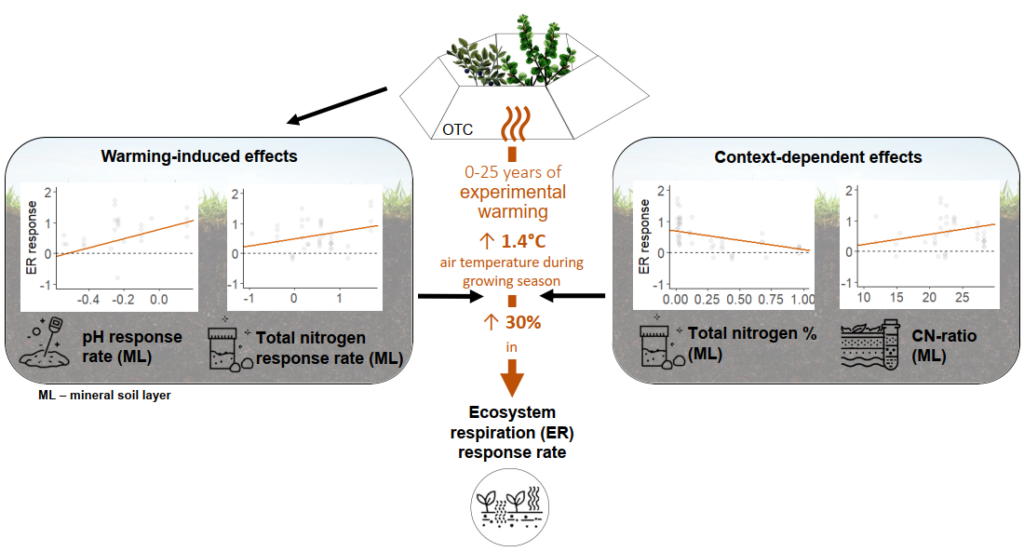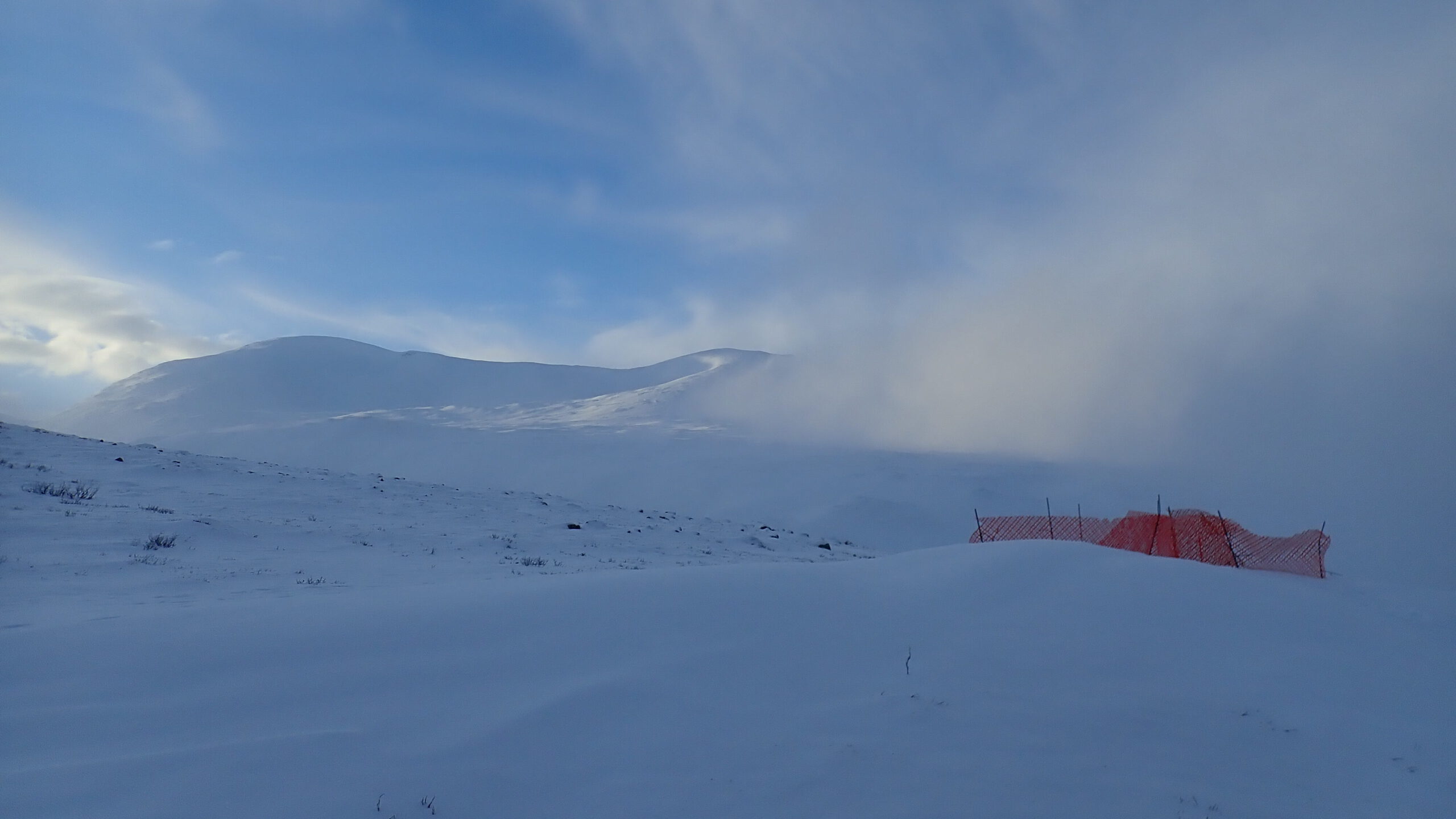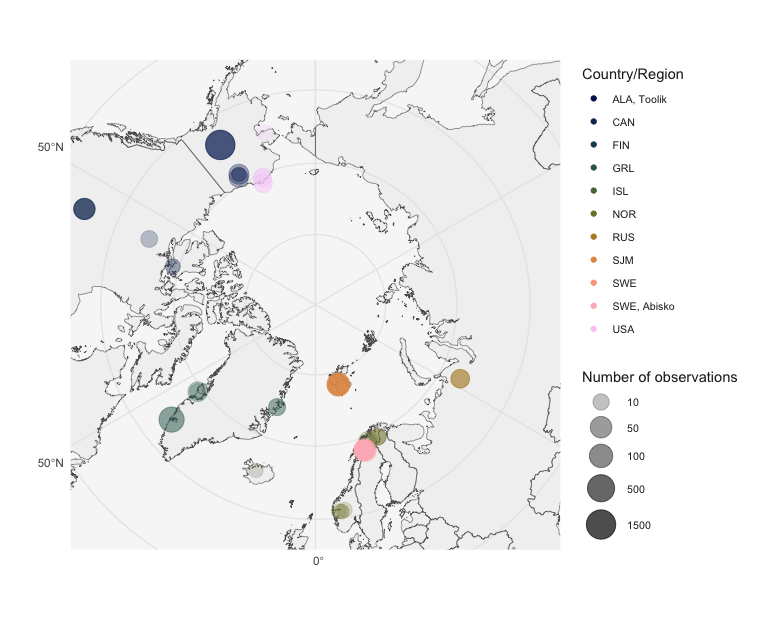Environmental drivers of increased ecosystem respiration in a warming tundra (Nature 2024)
https://doi.org/10.1038/s41586-024-07274-7
led by Sybryn Maes from KU Leuven

Abstract
Arctic and alpine tundra ecosystems are large reservoirs of organic carbon1,2. Climate warming may stimulate ecosystem respiration and release carbon into the atmosphere3,4. The magnitude and persistency of this stimulation and the environmental mechanisms that drive its variation remain uncertain5,6,7. This hampers the accuracy of global land carbon–climate feedback projections7,8. Here we synthesize 136 datasets from 56 open-top chamber in situ warming experiments located at 28 arctic and alpine tundra sites which have been running for less than 1 year up to 25 years. We show that a mean rise of 1.4 °C [confidence interval (CI) 0.9–2.0 °C] in air and 0.4 °C [CI 0.2–0.7 °C] in soil temperature results in an increase in growing season ecosystem respiration by 30% [CI 22–38%] (n = 136). Our findings indicate that the stimulation of ecosystem respiration was due to increases in both plant-related and microbial respiration (n = 9) and continued for at least 25 years (n = 136). The magnitude of the warming effects on respiration was driven by variation in warming-induced changes in local soil conditions, that is, changes in total nitrogen concentration and pH and by context-dependent spatial variation in these conditions, in particular total nitrogen concentration and the carbon:nitrogen ratio. Tundra sites with stronger nitrogen limitations and sites in which warming had stimulated plant and microbial nutrient turnover seemed particularly sensitive in their respiration response to warming. The results highlight the importance of local soil conditions and warming-induced changes therein for future climatic impacts on respiration.
Data Availability
https://doi.org/10.5281/zenodo.10572479
Code Availability
https://github.com/mjalava/tundraflux
The effect of snow manipulation on ecosystem respiration in all seasons

Winter is the most distinctive season for the Arctic as it also lasts considerably longer than the summer. Yet, the winter months are particular understudied even though they are expected to change the most in terms of climate with increasing temperatures and precipitation. Climate warming can contrastingly affect respiration rates across northern biomes due to the crucial importance of snow cover: Increasing winter precipitation results in soil warming in the arctic. Warmer soils in winter (e.g., through a thicker snow cover due to more precipitation) likely increase activity and amount of decomposers leading to increased respiration rates compared to soils with reduced snow cover depth. Midwinter snowmelt events, on the other hand, can induce more severe soil frost in arctic ecosystems. Reduced snow cover in winter or late snow fall in autumn rather inhibit decomposers and respiration as a result of less insulation and, therefore, lower soil temperatures.
In this project, we will investigate how snow manipulations during the winter months affect the ecosystem’s respiration over the seasons.
Methane Dynamics in a warming arctic
led by Jan Dietrich from Umeå University & Mats Björkmann from University of Gothenburg

Climate change in warming is supposed to alter the methane cycle in the arctic tundra. Methane is more potent as carbon dioxide as a green house gas, however stays only a limited amount of time in the athmosphere. The effects of climate change on methane fluxes in Arctic ecosystems can be simulated by passive warming experiments. However, the impact of warming on the arctic methane cycle are largly heterogenous. Escpecially the spatial extent of wet and dry ecosystems are not fully taken into account when summarising the arctic methane balance. In this study, we attempt to quantify the effects of passive warming experiments on net methane fluxes in the arctic tundra and identify critical influencing factors. We examine how the balance between methanoxidation and methanogenesis in the arctic tundra is altered by climate warming.
WrPMIP
by Christina Schädel from the Woodwell Climate Research Center, and Ted Schuur and Jon Wells from Northern Arizona University
https://warmingpermafrost.nau.edu/
Capturing permafrost carbon dynamics in process-based Earth System Models is crucial for accurately projecting the magnitude and timing of permafrost carbon emissions and thus the rate of global climate change. While numerous experimental and modeling efforts are improving understanding of the magnitude and underlying mechanisms of permafrost carbon dynamics, there is a disconnect between experimental and modeling approaches and large uncertainties remain. Manipulative field-based experiments provide an opportunity to inform long-term projections about the magnitude and underlying mechanisms of permafrost carbon dynamics in a changing Arctic.
In this project, we will perform multi-model simulations at the regional and site-level scale that align with experimental perturbations (open top chambers, snow fence experiments) to a) assess coherence among models, b) evaluate model performance against data, and c) inform future measurements.
TundraFlux: A database of ecosystem respiration and associated biotic and abiotic data from Arctic and alpine warming experiments

led by Sarah Schwieger from Umeå University
Sharing the assembled data on ecosystem respiration (Reco) from open-top chamber expriments (OTCs) and making it openly available to the scientific community has been a central goal of the TundraFlux project from the beginning. Our mission is to enable a broader understanding of how climate warming affects carbon cycling in Arctic and alpine tundra ecosystems.
To that end, we are preparing to publish a curated dataset of Reco measurements from OTC warming experiments. These data represent 5416 daily averaged carbon dioxide flux measurements collected across 24 years and 68 sites, involving over 70 contributors from over 12 countries. Each data point reflects a significant investment of time, energy, and collaboration. Together, they offer a powerful resource for testing ecological hypotheses, improving process-based models, and refining global carbon budgets. This publication will include detailed metadata on vegetation, soils, and methods, enabling users to subset and explore the data in meaningful ways.
We believe that transparency, collaboration, and open science are key to accelerating climate research. By making these data publicly available, we hope to support new discoveries and foster a deeper, data-driven understanding of tundra ecosystems under climate change.